My husband, Glenn, is sharing these daily lessons for our West Huntsville family as we are necessarily (because of the virus) spending less time physically together in worship, study and fellowship. We may be “socially distanced,” but we’re a close-knit family and we want to keep it that way! One way to stay on track together, spiritually, is to think about a common passage and make applications for our lives together even when we are unable to assemble as frequently. I’m sharing these daily family lessons here for those in other places, whose families (or even congregations) might benefit from a common study in these uncommon days of semi-quarantine. There are Family Bible Time guides included, as well. You can adapt, shorten or lengthen them according to the ages of kids (and adults) in your family. Blessings.
From Glenn:
My Favorite Proverbs: The Deadly Way that Seems Right (Prov. 14:12)
 “There is a way that seems right to a man, but its end is the way of death.”
“There is a way that seems right to a man, but its end is the way of death.”
There are some things that are beyond our language to adequately describe. The gap between our mortal intelligence and God’s intelligence is one of those things. Isaiah sounds awe-struck when he writes, “For as the heavens are higher than the earth, so are My ways higher than your ways, and My thoughts than your thoughts” (Isa. 55:9). While thinking on that, add this verse into your meditation: “Thy word is a lamp to my feet and a light to my path” (Psa. 119:105). He is omniscient, omnipresent, and omnipotent. By comparison, we are mortal and limited, and utterly dependent on Him every day (Matt. 5:45).
Men are too proud when they boast of their life choices that are contrary to the Bible, while none of them have died and returned to tell how things worked out for them. They are replaced by yet more worldly men who “preach” their methods of living. Every generation produces its hedonists, agnostics and atheists. In addition, for those who love to be religious but don’t feel religion necessarily has to reflect the Scriptural pattern, here’s Jesus’ warning, “And in vain they worship Me, teaching as doctrines the commandments of men.’ (Matt. 15:9).
In the church of Christ we want the Bible to be our final authority for our faith and practice. Some of our practices may seem strange to people…practices such as eating the Lord’s Supper every Sunday or insisting that baptism is necessary to be saved, or having only men to be our preachers. But we practice these because of our determination to adhere to God’s word on these subjects (Acts 20:7, 1 Pet. 3:21, Acts 22:16, 1 Tim. 2:11-14). There is no biblical authority for telling a lost person that, to be saved, he must pray the sinner’s prayer or “accept Christ as your personal Savior.” Where did any of the New Testament churches use instrumental music with their vocal/a capella music? It isn’t there. Do we read of women preaching for the church assemblies in the New Testament? Was sprinkling ever a God-approved substitute for immersion in water when a person was baptized? If these are matters that seem unimportant or ambiguous to you, I’d love to communicate with you about them. Let’s talk about the importance of authority.
Today, meditate on this proverb and then, “… whatever you do in word or deed, do all in the name of the Lord Jesus, giving thanks to God the Father through Him” (Col. 3:17).
Bible time with Glenn and Cindy:
Whoosh! Tonight (as I’m writing, it’s Sunday) was an exciting night at the Colley’s house. The wind became fierce and a huge tree fell down on the power lines on our street, placing a live wire across our yard and, of course, knocking out transformers and power. Our neighbors across the street had a pretty good sized tree right on their front porch! I was planning to share something else tonight, but since this huge wind came through some of your neighborhoods tonight, let’s think about some of the times in our lives when we might have instant needs around us, that we, as God’s people could fill. Are there some times when we can more easily show people a servant heart?
It was pretty fun tonight to see neighbors immediately working with chain saws, loaning generators and going to check on each other, even in the middle of a pandemic. Let’s see, tonight, if we can get our kids to think about times when it might be easier to find opportunities to serve.
- Try to get them to think of the things we’ve been able to do during this COVID time that we
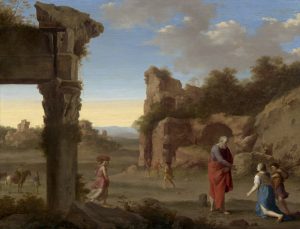 otherwise would not have done (making masks, doing drive-by parades for cheer etc…).
otherwise would not have done (making masks, doing drive-by parades for cheer etc…). - What are some “extra” ways people minister to needy people when there are storms? Help them think of these ways.
- What are some times in life when we have the chance to, on-the-spot, pray for people who are in an emergency situation? Do you do this when you see a wreck or a house on fire, even if you do not know the people involved? Start this practice with your children if you do not already do this.
- Review with your children the definition and consequences of a famine. Turn with them to 1 Kings 17 and tell them the account of Elijah going to the widow of Zarephath. Explain to them that she was not a citizen of Israel, the nation that really knew God. Elijah had a chance to do some really needed things for her; first because of a famine and, then, because of a death in her family. Make sure they see that, in the beginning of the account she referred to your God (verse12), but by the end (verse 24), she believed in Jehovah and the truth of Elijah’s message.
- Do you think that people sometimes come to trust God because they can see the good things that His people do? Read Matthew 5:16 and discuss this with your children. We cannot do miracles like Elijah, but can we still show people the love that God has for them when we minister to their needs? Try to get your children to think of some occasion when your family has helped someone who has later come to the Lord.
- If you’ve never experienced this wonderful phenomenon, try to think with your kids about someone you know who doesn’t know the Lord. Is there something good that you can do for this person or family this week to try and develop a relationship in which you can show them the Lord? Pray about this endeavor with your kids tonight.
Tomorrow night, we’ll try to get back into the meat of Matthew 25, if the Colleys have power to transmit. There are a few more nuggets there that we are hoping to cover.

 In light of our authority study, particularly the lengthy discussions and assignments the diggers have had about what is appropriate in worship to our God, some have asked about the appropriateness of dressing up and re-enacting a Bible account for our children in a class setting. Here are some points to consider while coming to the conclusion that it is not wrong to show children a Bible story in a class setting by acting it out.
In light of our authority study, particularly the lengthy discussions and assignments the diggers have had about what is appropriate in worship to our God, some have asked about the appropriateness of dressing up and re-enacting a Bible account for our children in a class setting. Here are some points to consider while coming to the conclusion that it is not wrong to show children a Bible story in a class setting by acting it out.

 The story of Masada is one of the most fascinating extra-Biblical Jewish/Roman accounts
The story of Masada is one of the most fascinating extra-Biblical Jewish/Roman accounts Herod the Great built the fortress (or at least re-made it for his purposes) during the third decade B.C.; in other words, around the time of the death of Jesus. Herod was a lot of things, but, above all, he was taken with himself and wrapped up in His own quest for power, often even to the point of psychotic narcissism. One can easily see this self-aggrandizement when looking at the remains of his two palaces here at Masada. They were large and luxurious.
Herod the Great built the fortress (or at least re-made it for his purposes) during the third decade B.C.; in other words, around the time of the death of Jesus. Herod was a lot of things, but, above all, he was taken with himself and wrapped up in His own quest for power, often even to the point of psychotic narcissism. One can easily see this self-aggrandizement when looking at the remains of his two palaces here at Masada. They were large and luxurious. We could see three connected terraces, his personal bath and remains of his large personal bedroom in the Northern palace. There was another very large bath, nearby, probably used for the senior Masada officials in the days of Herod. It’s hard to imagine the opulence of the tile Mosaics and the spectacular views if you’ve not witnessed them personally.
We could see three connected terraces, his personal bath and remains of his large personal bedroom in the Northern palace. There was another very large bath, nearby, probably used for the senior Masada officials in the days of Herod. It’s hard to imagine the opulence of the tile Mosaics and the spectacular views if you’ve not witnessed them personally.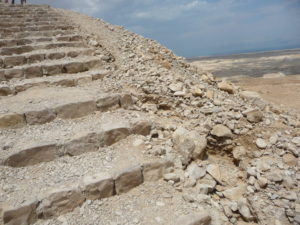 The wall of Herod’s Masada was 1400 meters long and 4 meters wide with rooms built in between the two parallel walls. The water supply in this dry wilderness was secured by large cisterns on the northwestern side of the hill. We were told that one large rain, which generally occurred twice a year, could supply enough water for Masada’s residents for three years.
The wall of Herod’s Masada was 1400 meters long and 4 meters wide with rooms built in between the two parallel walls. The water supply in this dry wilderness was secured by large cisterns on the northwestern side of the hill. We were told that one large rain, which generally occurred twice a year, could supply enough water for Masada’s residents for three years.
 Sitting in the lavish synagogue, built there by Herod (not that he was by any means a devout Jew, but, rather, he built the synagogue for political purposes), I mused on so many facets of the tragic events that unfolded as the Jews’ last hold-out against the Romans lay under siege and finally was destroyed, as the enemy breached the wall and found the bodies of the self-slain Jews. I thought about the three skeletons that were found in the bathhouse—those of a man, a woman and a child. I walked through that bathhouse as I heard about the woman’s still beautifully-braided hair and the preserved sandals next to her. I listened as we were told about the bits and pieces of the man’s armor, probably taken from the Romans in an earlier skirmish by the rebel Jews. I pondered the ornately decorated room, in the Western palace, a palace that covered an entire acre…decorated with beautiful mosaics…the room that was likely the Masada throne room of the Herod. This was the same Herod who found it in his heart to kill the baby boys at the time of the birth of the Savior (along with the killings of several members of his own royal household, including his wife.) He vacationed and found refuge (at least physical refuge) here, at Masada. I contemplated the contrast between the lavish lifestyle flaunted by Herod in those two sumptuous palaces and the stench of death that greeted the Roman legion as they forced their way through the breach in the double wall. How much can change and how quickly in the fulfillment of the will of God!
Sitting in the lavish synagogue, built there by Herod (not that he was by any means a devout Jew, but, rather, he built the synagogue for political purposes), I mused on so many facets of the tragic events that unfolded as the Jews’ last hold-out against the Romans lay under siege and finally was destroyed, as the enemy breached the wall and found the bodies of the self-slain Jews. I thought about the three skeletons that were found in the bathhouse—those of a man, a woman and a child. I walked through that bathhouse as I heard about the woman’s still beautifully-braided hair and the preserved sandals next to her. I listened as we were told about the bits and pieces of the man’s armor, probably taken from the Romans in an earlier skirmish by the rebel Jews. I pondered the ornately decorated room, in the Western palace, a palace that covered an entire acre…decorated with beautiful mosaics…the room that was likely the Masada throne room of the Herod. This was the same Herod who found it in his heart to kill the baby boys at the time of the birth of the Savior (along with the killings of several members of his own royal household, including his wife.) He vacationed and found refuge (at least physical refuge) here, at Masada. I contemplated the contrast between the lavish lifestyle flaunted by Herod in those two sumptuous palaces and the stench of death that greeted the Roman legion as they forced their way through the breach in the double wall. How much can change and how quickly in the fulfillment of the will of God!
 It was still our first full day of traveling in Israel. During the early afternoon we saw the ruins of a civilization that played a role of major importance in Bible History from the time of Abraham to the close of the Old Testament: Beersheba. First named by Abraham in Genesis 21, its name means “well of the oath,” thus named because of the oath made with Abimelech. (Photo below is an Iron age well in Beersheba, but very reminiscent of the wells of Abraham. It doesn’t take long to figure out in this Negev desert why there were contentions over the wells. Water is a valuable commodity, to this day, in this part of the world.)
It was still our first full day of traveling in Israel. During the early afternoon we saw the ruins of a civilization that played a role of major importance in Bible History from the time of Abraham to the close of the Old Testament: Beersheba. First named by Abraham in Genesis 21, its name means “well of the oath,” thus named because of the oath made with Abimelech. (Photo below is an Iron age well in Beersheba, but very reminiscent of the wells of Abraham. It doesn’t take long to figure out in this Negev desert why there were contentions over the wells. Water is a valuable commodity, to this day, in this part of the world.)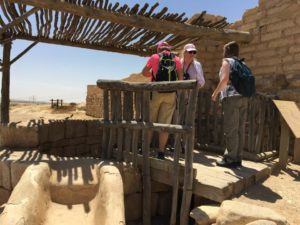

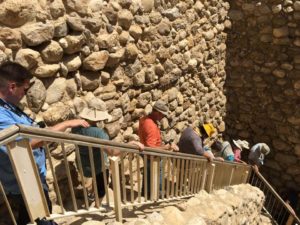 Significantly, I Samuel 8:2 tells us that Samuel’s sons, Joel and Abiah, were judges in Beersheba. Verse three tells us that they failed to walk in the way of Samuel, but rather took bribes and perverted judgment. This was in direct violation of Deuteronomy 16: 18-19. The Israelites clamored for a human king at this time, in a bold-faced rejection of their current king, Jehovah, using the depravity of Joel and Abiah as the catalyst excuse for rejecting God: Behold, thou art old, and thy sons walk not in thy ways: now make us a king to judge us like all the nations (vs 5).
Significantly, I Samuel 8:2 tells us that Samuel’s sons, Joel and Abiah, were judges in Beersheba. Verse three tells us that they failed to walk in the way of Samuel, but rather took bribes and perverted judgment. This was in direct violation of Deuteronomy 16: 18-19. The Israelites clamored for a human king at this time, in a bold-faced rejection of their current king, Jehovah, using the depravity of Joel and Abiah as the catalyst excuse for rejecting God: Behold, thou art old, and thy sons walk not in thy ways: now make us a king to judge us like all the nations (vs 5).
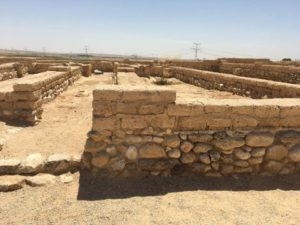
 I’ve spent more time than perhaps I should’ve this week contemplating the issue of the head covering from 1 Corinthians 11. I think it’s hard for any of us, in 2019, who are sisters in the kingdom of God to approach the study without any preconceived ideas. I tried to be open and honest as I looked at the teaching, but I confess that I do not want to wear the head covering. The chief reason I do not want to wear it is that my husband—my head—-does not want me to wear it. He’s convicted that it is not commanded for women in America, in 2019, and he believes that my wearing it would be a contentious and impeding action. However, he is, as always kind and protective of my conscience. Both of us understand that, if it is commanded by God for me to do so, then our fears and concerns about anything else, are irrelevant. But if it is not a requirement for women in the 21st century, it’s our judgment that it is best for me not to wear the head-covering, particularly after examining what it actually was and when it was worn.
I’ve spent more time than perhaps I should’ve this week contemplating the issue of the head covering from 1 Corinthians 11. I think it’s hard for any of us, in 2019, who are sisters in the kingdom of God to approach the study without any preconceived ideas. I tried to be open and honest as I looked at the teaching, but I confess that I do not want to wear the head covering. The chief reason I do not want to wear it is that my husband—my head—-does not want me to wear it. He’s convicted that it is not commanded for women in America, in 2019, and he believes that my wearing it would be a contentious and impeding action. However, he is, as always kind and protective of my conscience. Both of us understand that, if it is commanded by God for me to do so, then our fears and concerns about anything else, are irrelevant. But if it is not a requirement for women in the 21st century, it’s our judgment that it is best for me not to wear the head-covering, particularly after examining what it actually was and when it was worn.